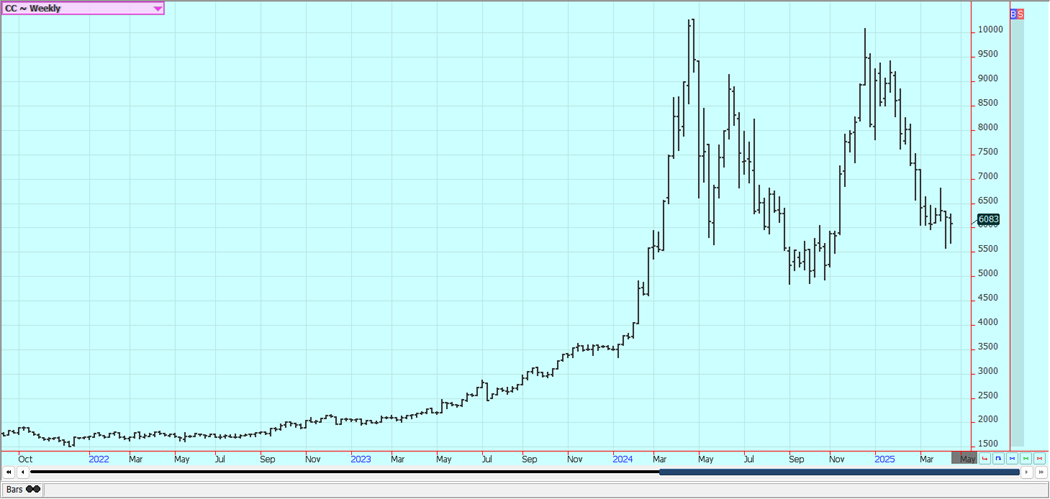Jack Scoville
Jack Scoville is an often quoted market analyst in the grain and soft commodities sectors. You will find his commentary throughout the Reuters, Wall Street Journal, Dow Jones, Bloomberg, and Barron's publications. Contact Mr. Scoville at (312) 264-4322
Translate





Weekly Ag Markets Update – 04/21/2025
Wheat: All three markets closed lower last week as futures found new support from stronger world market prices but as the weather for growing crops improved with more reports of showers in western growing areas. Rain has become much less in the southern Midwest and Mid South but flooding reports continue. The White House made a pause in the implementation of the reciprocal tariffs for 90 days but is still imposing blanket tariffs on most of the world and is maintaining the old Mexican and Canadian tariffs. The tariffs will cost producers more for inputs and should damage upside price potential if the reciprocal tariffs start again. Chart trends are up in Winter Wheat markets and in Minneapolis. Dry outlooks for the Great Plains and Black Sea regions are still the main feature. Overall demand has been weak.
Weekly Chicago Soft Red Winter Wheat Futures
Weekly Chicago Hard Red Winter Wheat Futures
Weekly Minneapolis Hard Red Spring Wheat Futures
Corn: Corn closed lower last week as demand for US Corn mains strong. The market also reacted to better planting weather in the Midwest and the latest in the tariff wars. Demand for Corn in domestic and world markets remains strong with inspections above 1.8 million tons and sales of above 1.5 million tons in the latest reporting week. It is dry in growing areas in western US, but most of the Midwest has had precipitation lately and eastern and southern areas are too wet. It has become warmer in a lot of the Midwest and planting progress is expected to be much improved this week. Oats were higher and the trends are up in this market.
Weekly Corn Futures
Weekly Oats Futures
Soybeans and Soybean Meal: Soybeans and Soybean Meal closed a little lower last week and Soybean Oil was a little higher as the market reacted to news of better demand due to high Brazil FOB premiums. There was news last week that the reciprocal tariffs have been put on pause for 90 days. The world wide tariff of 10% remains intact as do tariffs on Mexico and Canada. The reports of demand have remained solid for US Soybeans as China has been taking almost all the export from South America. Deferred months were higher as the weather remains too wet to the east and south and too dry to the west. Warmer temperatures are expected this week.
Weekly Chicago Soybeans Futures
Weekly Chicago Soybean Meal Futures
Rice: Rice closed lower last week but futures are still holding to a sideways trend. Prices remain cheap and could threaten the planted area as it will cost more to produce Rice than it is getting in the market right now. Export sales have not been strong, and domestic demand is not strong enough right now to bid prices any higher. Milling quality of the Rice remains below industry standards and it takes more Rough Rice to create the grain for sale to stores and exporters. Rice is getting planted in southern growing areas now and is trying to get started farther to the north.
Weekly Chicago Rice Futures
Palm Oil and Vegetable Oils: Palm Oil futures were higher last week as the outside markets were also higher. There is talk of reduced supplies in the market due to extreme weather that caused fields to flood among other things, but inventories are expected to improve in coming weeks. Demand ideas are weaker. Chart trends are mixed. Canola was higher last week and trends are up on the daily charts. Canadian goods were exempted from the new round of tariffs but still must deal with the tariffs previously imposed by the US. Canada will not be exempted by the 90 day pause.
Weekly Malaysian Palm Oil Futures
Weekly Chicago Soybean Oil Futures
Weekly Canola Futures
Cotton: Cotton was a little higher last week on hopes for improving growing weather in most areas and on demand concerns from the tariff battles as demand has been holding for now. The lack of change in the China tariffs hurt demand ideas as did news that the US has warmed other countries not to act as intermediaries for the Chinese in trade deals and imports and exports. USDA made no changes to the production estimates or total supply but did cut export demand by 10 million bales and increased ending stocks levels to 5.0 million bales. World stocks estimates were also higher. Some rain was reported in west Texas last week to help ease drought concerns and potential supply problems, and farmers are in the fields. More showers are in the forecast for the Great Plains.
Weekly US Cotton Futures
Frozen Concentrated Orange Juice and Citrus: FCOJ closed higher last week as the uptrend in this market continued. USDA reported a slight increase in US oranges production in its reports released on Thursday. The increase was in California and will not have effect on the production of FCOJ in Florida. Trends are turning up for the short term. The short term supply scenario remains tight but is now a little loose. The reduced Florida production appears to be mostly at the expense of the greening disease and some extreme weather seen in the last couple of years. There are no weather concerns to speak of for Brazil or Florida right now although Brazil could turn hot and dry.
Weekly FCOJ Futures
Coffee: Both markets closed higher last week on ideas of good demand against ideas of less supplies available to the market. The lack of offers from Brazil continues. The Vietnam harvest is over, but producers are holding back on some beans. Safras e Mercado said that farmers have sold 12% of the harvest so far this year from a more normal 25% last year. Hot and dry weather is in the forecast for Brazil longer term. Trends are up on the daily charts.
Weekly New York Arabica Coffee Futures
Weekly London Robusta Coffee Futures
Sugar: Both markets were lower last week. Ideas of good supplies and less demand continue, although demand ideas got a boost from the latest tariff news late last week. President Trump paused the implementation of the tariffs for 90 days, but the world tariff of 10% remains intact as do the previous tariffs on Mexico and Canada. There were reports of some scattered showers in center south Brazil and reports that India will have comfortable beginning stocks to help cushion the blow from reduced production for the coming year.
Weekly New York World Raw Sugar Futures
Weekly London White Sugar Futures
Cocoa: New York and London closed a little lower on fears that the world was entering a recession or depression due to the Trump tariff moves of last week. Trends are down in London and in New York, and demand ideas got hurt as the tariffs will increase costs to US buyers of chocolates. Demand ideas have been under pressure on the high prices currently seen for Cocoa due to bad production in West Africa. Cocoa imports are now subject to a 10% tariff at minimum, but Ivory Coast is no longer facing tariffs up to about 21% as the reciprocal tariffs were paused for 90 days.
Weekly New York Cocoa Futures
Weekly London Cocoa Futures

Questions? Ask Jack Scoville today at 312-264-4322